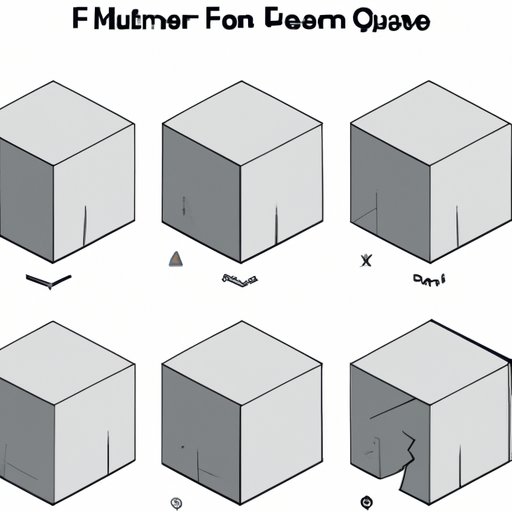
Introduction
Cubic feet is a unit of volume measurement that helps in determining the amount of space an object occupies in three dimensions. Whether you are renovating your home, shipping products, or installing heating and cooling systems, understanding how to measure cubic feet is crucial. Measuring cubic feet is essential in everyday situations and can save you from making costly errors. In this article, we will explore different approaches to measuring cubic feet.
A step-by-step guide on how to measure cubic feet
Before we go into measuring cubic feet, it’s essential to understand what it means. Cubic feet is a three-dimensional measurement that involves multiplying the object’s length, width, and height. The tools required to measure cubic feet include a measuring tape, a level, and a calculator.
To measure cubic feet, you need to:
1. Measure the length, width, and height of the object in feet.
2. Multiply the three dimensions; length, width, and height, to get the total volume in cubic feet.
Measuring Regular Shapes
Measuring regular shapes such as cubes, rectangles, and cylinders is relatively easy. Let’s break down the steps needed for each:
Cubes:
– Measure one side of the cube using a measuring tape.
– Multiply the length by itself twice to get the total volume in cubic feet.
– For example, if the length of one side of the cube is 3 feet, the cubic feet would be 3ft x 3ft x 3ft = 27 cubic feet.
Rectangles:
– Measure the length, width, and height of the rectangle using a measuring tape.
– Multiply the length, width, and height of the rectangle to get the total volume in cubic feet.
– For example, if the length is 3 feet, the width is 2 feet, and the height is 5 feet, the cubic feet would be 3ft x 2ft x 5ft = 30 cubic feet.
Cylinders:
– Measure the radius of the cylinder and the height using a measuring tape.
– Calculate the area of the base by multiplying pi (3.14) by the radius squared.
– Multiply the area of the base by the height of the cylinder to get the total volume in cubic feet.
– For example, if the radius is 2 feet, and the height is 6 feet, the cubic feet would be 3.14 x 2ft x 2ft x 6ft = 75.36 cubic feet.
Measuring Irregular Shapes
Measuring irregular shapes can pose a challenge since they have no defined parameter. Irregular shapes include pyramids and triangles, which require a different approach to measuring cubic feet. Let’s break down the steps required for each:
Triangles:
– Measure the base and height of the triangle using a measuring tape.
– Multiply the base by the height.
– Divide the result by two to obtain the area of the triangle.
– Multiply the area of the triangle by the height to obtain the total volume in cubic feet.
– For example, if the base is 6 feet, the height is 3 feet, and the height of the triangle is 4 feet, the cubic feet would be (6ft x 3ft) / 2 x 4ft = 36 cubic feet.
Pyramids:
– Measure the base and height of the pyramid using a measuring tape.
– Square the base to obtain the area of the square base.
– Multiply the area of the base by the height of the pyramid.
– Divide the result by three to obtain the total volume in cubic feet.
– For example, if the base is 4 feet, height is 3 feet, and the height of the pyramid is 5 feet, the cubic feet would be (4ft x 4ft) x 5ft / 3 = 26.67 cubic feet.
Infographic tutorial on measuring cubic feet
Visual aids, particularly infographics, help to explain complex ideas in a simple and engaging way. In this section, we will create an infographic tutorial on how to measure cubic feet for different shapes.
It’s important to note that the infographic tutorial is meant to supplement the step-by-step guide and not replace it. Here are a few tips to ensure accuracy when using the infographic tutorial:
– Ensure that the infographic is to scale before measuring it.
– Follow the procedural instructions correctly to avoid making errors.
– Double-check your measurements before calculating the cubic feet.
Common scenarios for measuring cubic feet
Measuring the cubic feet is important in different scenarios, including:
– Measuring the size of a room for an A/C installation.
– Measuring the dimensions of a box to ensure the item fits inside before shipping.
– Measuring the dimensions of a sofa or table to ensure they fit in a specific space.
Video tutorial on measuring cubic feet
A video tutorial can help in demonstrating how to measure cubic feet for different shapes. Here are a few tips and tricks to make the process of measuring cubic feet simple and efficient:
– Use a high-quality video camera to ensure the tutorial is clear.
– Provide a detailed explanation of each step to avoid confusion.
– Show examples for each of the different shapes to help viewers understand the process.
Problem-solving approach to measuring cubic feet
Measuring cubic feet can be challenging, especially when dealing with objects with curved or uneven edges. Here are a few strategies to ensure accuracy when measuring:
– Divide the object into sections with defined parameters and calculate the volumes separately.
– Use liquid displacement to calculate the volume indirectly.
– Use online tools to calculate the volume accurately.
Conclusion
Measuring cubic feet is crucial in everyday situations, whether you are renovating your home, shipping products, or installing heating and cooling systems. With the different approaches discussed in this article, measuring cubic feet should be easy and efficient. Ensure that you use the right tools and strategies for each shape to avoid making costly errors.




